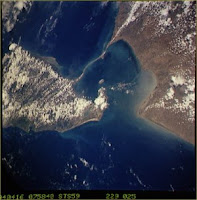Ram's bridge controversy: Religious claim vs scientific evidence

Thanks to Don for bringing this to my attention. This is an interesting issue regarding science & religion. The dispute is about building a canal near a geological feature known as Ram's bridge (or Adam's bridge) that lies in between India and Sri Lanka.
The canal project proposes to link the Palk Strait with the Gulf of Mannar between India and Sri Lanka by dredging a canal through the shallow sea.This is expected to provide a continuous navigable sea route around the Indian peninsula.
Once complete, the canal will reduce the travel time for ships by hundreds of miles and is expected to boost the economic and industrial development of the region.
However, there is sacred value attached to the same area:
Hindu devotees believe the area between India and Sri Lanka - now known as Adam's Bridge - was built millions of years ago by Lord Ram, supported by an army of monkeys.
Scientists and archaeologists say the Ram Setu (Lord Ram's bridge) - or Adam's Bridge as it is sometimes called - is a natural formation of sand and stones.
So the matter was in the courts and a report submitted by the government has sparked off protests:
In their report submitted to the court, the government and the Archaeological Survey of India questioned the belief, saying it was solely based on the Hindu mythological epic Ramayana.
They said there was no scientific evidence to prove that the events described in Ramayana ever took place or that the characters depicted in the epic were real.
Hindu activists say the bridge was built by Lord Ram's monkey army to travel to Sri Lanka and has religious significance.
Read the full story here. India's culture minister has now offered to resign due to this controversy and directors responsible for the report have been suspended.
So how should we address the issue? Was the government insensitive in saying that the religious explanation is solely based on a mythological epic? This is an issue where religious belief directly conflicts with scientific evidence and there may not be another way of dealing with it.
Perhaps we can think of Young Earth Creationists, who believe that the Earth is 6000 years old and that this belief is based on information from the Bible (by counting generations, etc). Should scientists be sensitive to this view when talking about, for example, plate tectonics? No, they shouldn't - there is absolutely no reason to consider the idea of a 6000 year old Earth for any scientific discussion.
A more complicated example is the dispute over the remains of the Kennewick Man - the skeletal remains of a person who died roughly 9000 years ago. These remains are of enormous value to scientists. Here the claim of some Native American tribes that the Kennewick Man was their direct ancestor and should be buried by traditional means was challenged by scientists who claimed that there is no direct lineage. The origin story of the Umatilla tribe says that people have been on their territory since the dawn of time and that the government claiming that Kennewick Man has no connection to the Tribe is basically a rejection of their beliefs. This gets more complicated because of complex ownership laws between the US government and Native American tribes.
Thus, these are areas where science & religion conflict is almost unavoidable. While sensitivity toward these issues is necessary, we should not shy away from stating scientific evidence. Yes, Dawkins would have a valid point here and in the case of Ram's bridge, Indian government was justified in saying that it is a natural geological formation.



.jpg)






0 comments:
welcome to my blog. please write some comment about this article ^_^